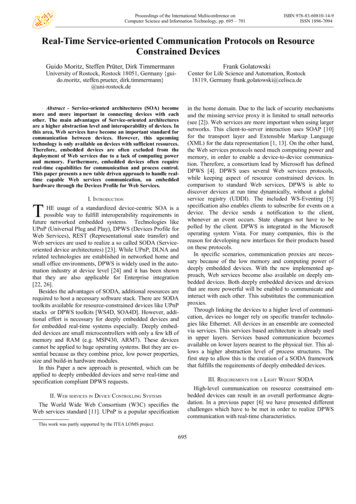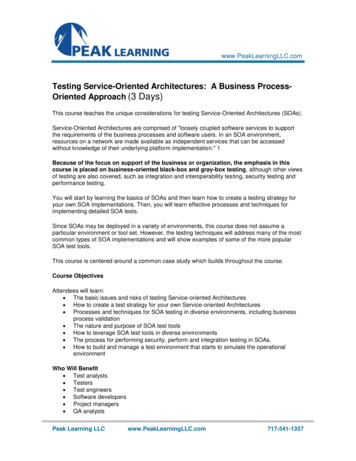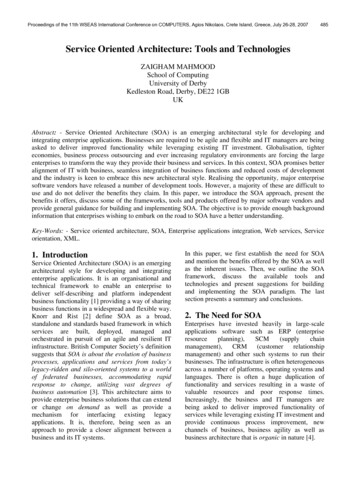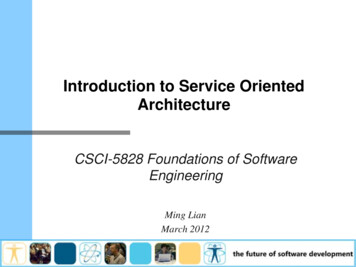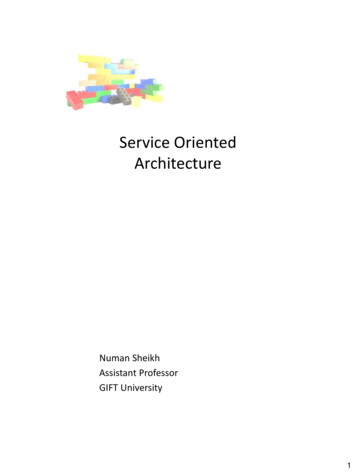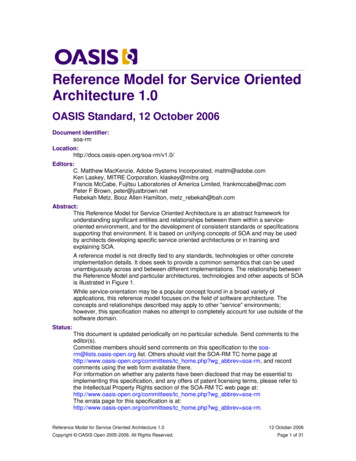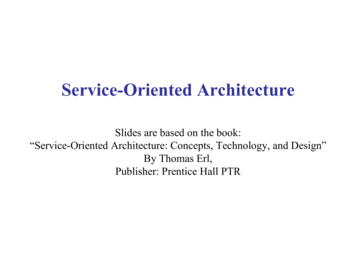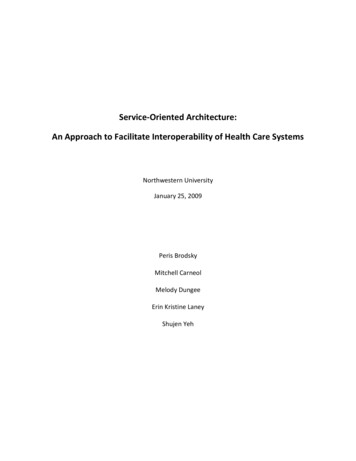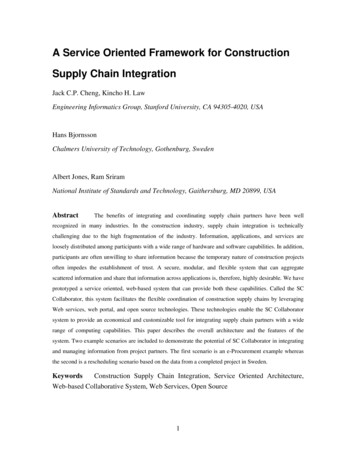
Transcription
A Service Oriented Framework for ConstructionSupply Chain IntegrationJack C.P. Cheng, Kincho H. LawEngineering Informatics Group, Stanford University, CA 94305-4020, USAHans BjornssonChalmers University of Technology, Gothenburg, SwedenAlbert Jones, Ram SriramNational Institute of Standards and Technology, Gaithersburg, MD 20899, USAAbstractThe benefits of integrating and coordinating supply chain partners have been wellrecognized in many industries. In the construction industry, supply chain integration is technicallychallenging due to the high fragmentation of the industry. Information, applications, and services areloosely distributed among participants with a wide range of hardware and software capabilities. In addition,participants are often unwilling to share information because the temporary nature of construction projectsoften impedes the establishment of trust. A secure, modular, and flexible system that can aggregatescattered information and share that information across applications is, therefore, highly desirable. We haveprototyped a service oriented, web-based system that can provide both these capabilities. Called the SCCollaborator, this system facilitates the flexible coordination of construction supply chains by leveragingWeb services, web portal, and open source technologies. These technologies enable the SC Collaboratorsystem to provide an economical and customizable tool for integrating supply chain partners with a widerange of computing capabilities. This paper describes the overall architecture and the features of thesystem. Two example scenarios are included to demonstrate the potential of SC Collaborator in integratingand managing information from project partners. The first scenario is an e-Procurement example whereasthe second is a rescheduling scenario based on the data from a completed project in Sweden.KeywordsConstruction Supply Chain Integration, Service Oriented Architecture,Web-based Collaborative System, Web Services, Open Source1
1. IntroductionA supply chain consists of a network of key business processes and facilities, involving end usersand suppliers that provide products, services, and information [33]. Traditionally, marketing,distribution, planning, manufacturing, and purchasing units and organizations along a supplychain often operate independently. The value of integrating members along supply chains hasbeen studied and identified in many industries [43, 53]. Supply chain integration helps reducecost, improve responsiveness to changes, increase service level, and facilitate decision making.In an integrated supply chain, information is shared and becomes available among the members.This enhances supply chain visibility and avoids information delays and distortions. Insufficientsupply chain visibility makes members vulnerable to quality and service level problems frombusiness partners and therefore subject to risks [17, 42]. Information delays and distortions leadto an increase in demand signal variation along the supply chain upstream, a phenomenon calledthe bullwhip effect [35]. Therefore, integration is one of the keys to effective supply chainmanagement.Construction is one of the largest industries in any country of the world [28]. In the UnitedStates, the value of construction put in place was 1,072 billion in 2008 [59], or 7.5% of the U.S.gross domestic product (GDP) that year [11]. There are many companies and many tradesinvolved in a construction project and development. Unfortunately, the construction industry isarguably the least integrated among all the major industrial sectors [25]. New [45] and Cox [20]have suggested that supply chain research in construction should focus on the development ofinteractive, inter-organizational relationships, which requires integration. However, the highfragmentation and project-based nature of the industry pose a significant challenge to crossenterprise integration of construction supply chains. Briscoe [10] has summarized eight keyattributes to successful construction supply chain integration, and this research focuses on two ofthem – managing communication and managing information flow.The characteristics ofconstruction supply chains lead to various requirements for information and collaborativesystems such as low cost and system adaptability. In the manufacturing industry, there are manyattempts to develop methodologies, technologies, and tools to integrate various applications forcommunication and collaboration among supply chain members. However, these technologiesand tools such as Electronic Data Interchange (EDI) and enterprise resource planning (ERP)2
systems often do not meet the needs and requirements for managing construction supply chains,due to their high cost, inflexibility to change, and lack of system extensibility.With rapid development of communication technology, the Internet has become ubiquitous andinstantaneously accessible. The proliferation of the Internet makes it the most cost effectivemeans of driving supply chain integration and information sharing [36]. Companies increasinglytake advantage of the Internet to create a virtual value chain where individuals and businesspartners can communicate and collaborate with each other.Utilizing the Internet as thecommunication network, the web services technology has emerged as a promising tool tointegrate distributed information sources and software functionalities in a flexible, scalable, andreusable manner.Web services technology enables a service oriented approach for theintegration of distributed information and applications on a network which supply chainmembers can connect to. The service units act as the components for various business functionsand can be reused and aggregated into a complex business process or workflow.Web portals have been used for information repository and sharing within a company as well asacross organizations. Because of its customizability of layouts and access control, a web portalprovides a secure, tailored way to deliver the right information to the right user at the right time.Although current web portals can be developed to discover and to deploy services, theirfunctions are usually fixed and cannot be changed or extended to external systems flexibly.Portal systems can become more flexible if the service oriented architecture (SOA) is adopted.In a service oriented portal-based framework, information and system operations are deployed asdiscrete web service units, which can be combined to perform different business tasks. Exposingthe web service units also allows internal information and system operations to be integratedwith other systems and applications, increasing the usability of the system and allowingautomation of business processes. In this paper, we will describe the service oriented portalbased framework and present the SC Collaborator system, a prototype system that we havedeveloped for managing construction supply chains.This paper is organized as follows: Section 2 provides the general background of constructionsupply chain, suggests the requirements for collaborative systems for the construction industry,and discusses the existing tools for supply chain integration and their shortcomings. Section 33
presents how some of these shortcomings can be avoided using a service oriented approach.Section 4 presents the service oriented portal-based framework, describes the architecture andfunctionalities of SC Collaborator for supply chain management, and discusses its suitability forthe construction industry. Section 5 presents two example scenarios to demonstrate the featuresof SC Collaborator for integrating various information and business functionalities. The secondexample scenario is drawn from a completed construction project in Sweden.Section 6concludes the paper with a brief summary and discussion on future works.2. Information Systems for Construction Supply Chain Integration2.1Construction Supply ChainsConstruction supply chains are characterized by the involvement of many companies from awide variety of trades [48]. A construction project involves a diverse group of participantsincluding contractors, architects, engineers, laborers, and developers [29]. A project of mediumto large scale typically involve hundreds of different companies supplying materials,components, and a wide range of construction services [21]. The multi-participant and multidomain characteristic is partly caused by the high fragmentation of the industry. According to astudy on the construction industry in the United States [40], the top eight architectural,engineering and construction (AEC) companies control less than twenty percent of the marketshare while by contrast the top companies in the aerospace industry control over seventy-fivepercent of all trades within the industry. This is probably due to the fact that the constructionindustry is comprised of countless companies from many different trades, most of which aresmall to medium in size. Furthermore, AEC companies tend to use a wide range of hardwareplatforms and software applications for their own operations, posing many technical challengesin integrating the construction supply chains.The temporary project-based nature of construction projects also hinders integration ofconstruction supply chains. Even though the processes can be similar for construction projectsof a specific kind, most construction projects create new products or prototypes and consist oftemporary supply chains that organizations need to be reconfigured for each project [61].Sharing of information and integration of systems require trust and coordination.Sinceconstruction supply chains are highly dynamic and the organizational structure and the project4
team change frequently, it is, therefore, unlikely for project participants to work together longenough on a project to build enough trust and to share information willingly. A secure andcustomizable support system may help establish trust and encourage integration during shortterm partnerships. A flexible system may facilitate adapting to new configurations and changesin supply chains. Based on the characteristics of construction supply chains, literature review,and feedbacks from practitioners in the industry, the following sections summarize the desirablerequirements of a collaborative platform to enhance communication among members andintegration of services in a construction supply chain.2.2System Requirements for Construction Supply Chain Integration2.2.1Ease of Installation and ConfigurationAs discussed in [58], an information infrastructure to interface the members of a supply chainshould simultaneously satisfy three requirements: (1) accommodating members with varyingdegrees of IT sophistication, (2) offering a wide range of functionalities, and (3) allowingconstantly changing pool of suppliers and customers. The third requirement is particularlyimportant for construction supply chains because additions, removals, and changes of projectparticipants such as the second tier suppliers are common in construction projects. Furthermore,construction companies often need to extensively customize each individual business applicationbefore usage, because every construction project is characterized by a unique set of siteconditions, project team, and relationships between project stakeholders [18].As a result,information systems for construction supply chain integration should be flexible to allow quickinstallation and configuration at the beginning of a project, and to enable easy re-configurationand adaption for changes throughout the project.2.2.2Low CostSmall and medium enterprises (SMEs) play a critical role as subcontractors and suppliers inconstruction supply chains. According to a study in the United Kingdom, about 83 percent of thecontracting companies in the private sector employ three or less workers [21]. Almost 98percent of all the companies employ 24 or less workers, which are generally defined as smallcompanies. Medium-sized companies that employ between 25 and 114 workers account for a5
further 2 percent. These SMEs are usually reluctant to invest much time, money, and effort ininformation systems and technologies. To create a network to support data exchange andcommunication among information sources and software applications can be expensive.Corporations routinely spend up to 50 percent of their information technology budgets onapplication integration [9]. Most of the SMEs in the construction industry are not able and/orwilling to make such a huge investment. Solutions that are economical are needed.2.2.3Ease of Connection and IntegrationAs noted earlier, ability to accommodate users with varying degrees of IT sophistication is one ofthe three requirements for supply chain information infrastructure [58].The requirementespecially applies to the construction industry because participants on a construction project arefrom a wide variety of domains and possess different levels of experience and educationalbackgrounds.In addition, according to the technology acceptance model (TAM) [23], theperceived ease of use of a system affects the early willingness to try and use the system and thesubsequent adoption of the system. Therefore, systems for managing construction supply chainsshould provide user-friendly and easily accessible communication interface. It is also importantthat the communication interface allows disparate systems to be connected through machineunderstandable protocols. In this way, information and applications residing inside a system canbe integrated with other applications and systems in the IT infrastructure of an organization orcompany.2.2.4Ability to Integrate External Systems and InformationSupply chains involve many participating companies that are geographically distributed inlocations. They may use different systems and keep their information separately. Not only is itdesirable to expose internal applications and system operations securely to external systems, butit is also beneficial to allow connection and integration with external systems and information ona collaborative project. Some companies may be using ERP or database systems to supportvarious business operations. A supply chain integration system should be able to access andcombine these distributed information sources and systems.6
Functionalities of a system become extensible if it can integrate external systems andinformation. Ability to extend the functionalities beyond an individual software system canfacilitate usage.For example, functionality of ERP systems usually is limited and fixed.Therefore, functionality is an important factor for the selection and successful implementation ofan ERP system [31, 32, 44]. An ERP system successfully implemented on one project may notbe applicable to another project. Different projects may need different system functionalitiesdepending on factors like the construction processes, project organizations, scopes of planningand management, hardware and software that the stakeholders use, and the materials andcomponents involved in the project. It is difficult and costly to customize functionalities of apre-packaged commercial ERP system typically for business applications for constructionprojects [64]. Many software packages such as CAD programs allow extension of functionalityvia application programming interface (API). Likewise, if collaborative systems for enterprisewide integration can conveniently extend their functionality, the usability of the systems will begreatly enhanced.2.2.5Customizable Access to Information and ApplicationsSecurity is an issue that many companies concern for collaborative systems. Some projectparticipants may be reluctant to share information with other participants who do not have adirect business relationship. For example, although a subcontractor may be willing to shareinformation with direct trading partners and suppliers, the subcontractor may not be willing toshare information with the suppliers of other subcontractors even though they are involved in thesame project. Moreover, many participants in construction projects work together on a projectbased relationship. It is often difficult for all the project participants to build enough trust andshare information with others.A system that enables users to control and customize theaccessibility of information and applications can promote information sharing.2.3Current Practices for Supply Chain Integration in the Construction IndustryGood communications and information sharing among various parties in construction projectsare critical and can be achieved through information technology integration [10, 21]. Somecompanies in the manufacturing industry establish communication networks using standardssuch as Electronic Data Interchange (EDI) to connect and exchange data with partners [24, 27,7
30]. However, the implementation of such communication infrastructures usually requires highcost and long configuration time, partly due to the lack of information standardization amongtrading partners.Recently, major construction companies have adopted enterprise resource planning (ERP)systems to integrate loosely distributed information and applications within and acrosscompanies [18].An ERP system is typically employed to seamlessly integrate all theinformation flowing through the company such as finances, accounting, human resources, supplychain, and customer information [22]. ERP systems can potentially enhance transparency acrossthe supply chain by eliminating information distortions and increase information velocity byreducing information delays [3]. Many corporations have implemented ERP systems to facilitatetheir front-end customer relationship and to support their back-end operations.ERP systems were not designed and are often not suitable for the construction industry [64].There are many research studies and efforts on selection and implementation of ‘generic’ ERPsystems in the construction industry [2, 18, 19, 52, 64]. Companies that use a generic ERPsystem often need to configure and customize it to support their own business needs. Thisconfiguration and customization process usually takes significant time, effort, and investment.In addition, most ERP systems on the market are mainly targeted to large companies with astable supply chain, while construction supply chains are unstable project-based in nature.Furthermore, adoption of ERP systems does not often result in significant improvement inproject performance as expected. One study estimated that 96.4% of ERP implementationsfailed [49] whereas another study reported that 70% of ERP implementations did not achievetheir estimated benefits [4].ERP systems have many limitations such as implementationcomplexity, integration problems, and customization problems [57].Akkermans et al. [3]concludes four major limitations of ERP systems as: (1) inflexibility to accommodate changes ofsupply chain structures, (2) lack of modular and open system architecture, (3) lack offunctionality beyond managing transactions, and (4) inability to share internal data efficientlywith supply chain partners.The Internet has emerged as a cost effective means of driving supply chain integration [36].Nowadays in the construction industry, information technology and the Internet have been8
leveraged to support multi-organizational collaborations.Examples include web-basedcollaborations for design and learning [14, 47, 54], for document and knowledge management[38, 65], and for project monitoring and management [13, 16, 46]. Figure 1 categorizes variousmeans that are currently used for web-based communication and collaboration in theconstruction industry.In particular, web-based project management systems (WPMS) andconstruction project extranets (CPE) have been increasingly used to support communication inconstruction projects [8, 46].CPE is a private network that is designed for the use ofco
Supply Chain Integration Jack C.P. Cheng, Kincho H. Law Engineering Informatics Group, Stanford University, CA 94305-4020, USA Hans Bjornsson Chalmers University of Technology, Gothenburg, Sweden Alber

